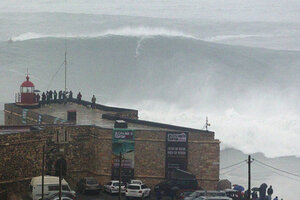Did a Brazilian surfer just catch the biggest wave ever, and save a life too?
Carlos Burle may have caught a 100-foot wave outside Nazare, Portugal. The last record-setting wave was also surfed in Nazare.

Brazilian surfer Carlos Burle rides a big wave at the Praia do Norte, north beach, outside the fishing village of Nazare in Portugal's Atlantic coast Monday, Oct. 28 2013. Surf media suggest it could be the biggest wave ever surfed.
AP/Miguel Barreira
While homes across Europe yesterday were battening their hatches against the wild and deadly St. Jude storm (named after the patron saint of lost causes), a Brazilian surfer paddled straight into the fray, rose to the top of a huge coastal swell, and sliced across what may have been the tallest wave ever surfed.
Carlos Burle, one of a handful of international big-wave surfers camped out in the small Portuguese fishing village of Nazare for the season, managed this feat just hours after rescuing close friend and award-winning Brazilian surfer Maya Gabeira from drowning after she wiped-out inside an earlier wave, according to eyewitness accounts.
When Ms. Gabeira surfaced face-down, floating toward a rocky outcropping, Mr. Burle reached her by jet ski, put her in a safe armlock, and navigated them both through Nazare's rough surf break, to the beach.
"I don’t think I’ve been so scared in my whole life," Burle told the surfing magazine Stab. "She has a broken ankle but she’s alive."
After Ms. Gabeira was resuscitated on the beach and pronounced out of danger, the rest of the group packed up. Burle was shaken but decided to ride his last wave of the day. It turned out to be a briny jackpot, a superwave that observers believe may have reached 100 feet into the stormy air.
The waves at Nazare's beach, Praia do Norte, became famous after U.S. surfer Garrett McNamara broke a world record there in 2011, when he careened down a 78-foot wave. In January 2013 Mr. McNamara may have beaten his own record, surfing a 100-foot wave whose measurements are still pending certification by Guinness World Records.
McNamara is among the crowd currently at Nazare, but yesterday he decided he didn't feel safe enough to surf. Instead, after the foam atop yesterday's staggering wave had chased Burle down its face, finally engulfing him and tearing his surfboard away, it was McNamara who fished him out and towed him to safety on a jet ski.
Amid waves as big as these, which move and break too quickly to traverse by arm-paddling, surfers take turns towing each other by jet ski to and from promising waves.
The New York Times described why Nazare is blessed with such a rare crop of towering waves:
"There are big wave spots far from land, like Cortes Bank 100 miles west of San Diego, Calif. But there are very few in coastal areas, because the gently sloping continental shelf normally flattens out the giants, gradually sapping their strength before they can reach land. But this small part of the Portuguese coast sits at the end of a giant funnel called the “canyon of Nazaré,” 130 miles long and 16,000 feet deep (at its deepest), that points like an arrow toward the town."
“It is like an earthquake,” a Nazare city hall administrator told the paper, describing the experience from shore. “When it breaks, you can feel the earth shaking under your feet."
It's unclear why the height of McNamara's January 2013 ride hasn't yet been confirmed by Guinness World Records, nor how long it might take to get an official confirmation of the wave Burle descended yesterday.
A breaking wave's height is measured from the top of its crest to the lowest point of water between it and the shore. Scott Stripling, a surfer and meteorologist at the National Oceanographic and Atmospheric Administration, says that photographic and video footage make it possible to estimate height by comparing something with a known length, like a board or a crouching surfer, against the expanse of water behind it.
"If you do that test," said Burle, "when you get a whole bunch of surfers stacked one on top of another, it looks like [yesterday's wave] might be one of the biggest ever."
Burle's group plans to remain in Nazare until Dec. 2 to ride out the silver lining of storm St. Jude.

